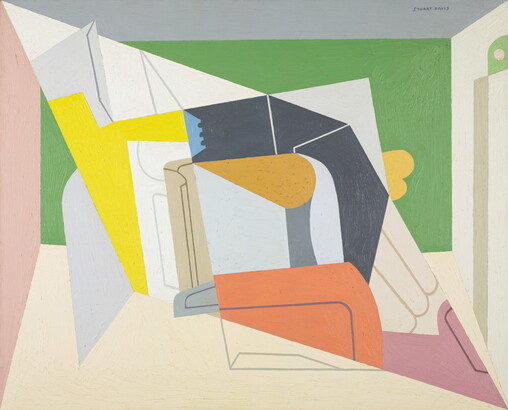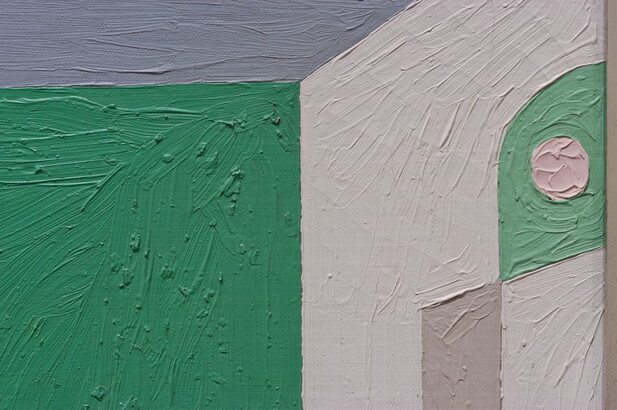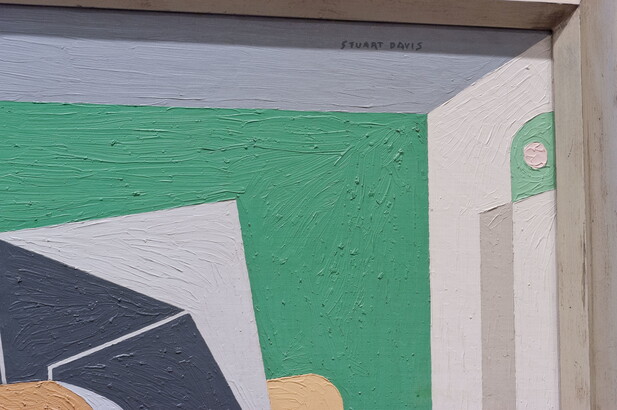












Artwork Images
Photo:
Controls
Egg Beater No. 2
Object Details
-
Date
1928
-
Object Type
Paintings
-
Medium
Oil on canvas
-
Dimensions
29 1/4 x 36 1/4 in.
-
Inscriptions
Recto:
signed u.r.: STUART DAVIS
Verso:
titled and signed white label on stretcher: EGG-BEATER / NO. 2 / Stuart davis
-
Credit Line
Amon Carter Museum of American Art, Fort Worth, Texas
-
Accession Number
1996.9
-
Copyright
Public domain
Object Description
From 1927 to 1928, Davis created a landmark group of four paintings known as the Egg Beater series. Nailing an electric fan, a rubber glove, and an eggbeater to a table, he worked exclusively from the still-life subject matter, devising a style based on cubist principles of fragmenting three-dimensional objects into two-dimensional forms.
In Egg Beater No. 2, the second work in the series, Davis fused the still-life elements within a diamond-like central shape in a palette of pastel colors. The ordinary household objects become unrecognizable as vigorous patterns of intersecting, flat, geometric forms. The series, and this work in particular, earned Davis renown as one of America’s most avant-garde artists.
-
Constructive Spirit: Abstract Art in South and North America, 1920s-50sJune 26–September 5, 2010
Featuring approximately 80 seldom-seen paintings, sculptures, prints, photographs, drawings, and films, this exhibition juxtaposes the work from artists of the Americas, providing a fresh and innovative look at this dynamic and cosmopolitan period of modernism.
-
American Vanguards: Graham, Davis, Gorky, de Kooning and their Circle, 1927-1942June 9–August 19, 2012
American Vanguards highlights the works and efforts of the charismatic John Graham and his circle of New York artists, who, along with forging their own identities in the art world, played a critical role in defining and shaping American modernism.
-
American Still LifeFebruary 14–August 16, 2015
Organized in celebration of a recent acquisition, American Still Life highlights the ability of 19th and 20th-century American artists to celebrate the ordinary through their paintings, whether trompe l’oeil masters or modernist photographers.
Additional details
Location: On view
See more by Stuart Davis
Tags
Video:
Video:
-
Why do artists create still lifes?
Why might an artist return to the same subject multiple times or in multiple works of art?
How can color, line, and shape represent objects?
How and why might an artist’s style change over time?
How have American still lifes changed over time? How have they remained the same?
-
All Levels
Students will create an abstract still life. Pose objects on a flat surface in front of students. Each student begins by dividing their paper into four parts by drawing one line down the center horizontally and one line down the center vertically. Students will then pick one object to draw four times in four different ways. Encourage students to think about textures, lines, and basic shapes.
Share Educator Resources
Amon Carter Disclaimer
This information is published from the Carter's collection database. Updates and additions based on research and imaging activities are ongoing. The images, titles, and inscriptions are products of their time and are presented here as documentation, not as a reflection of the Carter’s values. If you have corrections or additional information about this object please email us to help us improve our records.
Every effort has been made to accurately determine the rights status of works and their images. Please email us if you have further information on the rights status of a work contrary or in addition to the information in our records.
Related Works
-
The Fall of the Cowboy, 1895
Frederic Remington
Oil on canvas
1961.230
-
The Buffalo Hunt [No. 39], 1919
Charles M. Russell
Oil on canvas
1961.146
-
Martha Graham - Letter to the World (Swirl), 1940
Barbara Morgan
Gelatin silver print
P1974.21.17
-
Self-Portrait, 1919
Stuart Davis
Oil on canvas
1975.29
-
Drawing No. 18, 1919
Georgia O'Keeffe
Charcoal on paper
1997.2
-
The Time Game, 2011
Jane Hammond
Gelatin silver print
P2011.29
-
Sunrise, Yosemite Valley, ca. 1870
Albert Bierstadt
Oil on canvas
1966.1
-
Untitled, 1970
Luchita Hurtado
Lithograph
1970.86
-
Roseate Spoonbill, ca. 1980-85
Scott Gentling, Stuart Gentling
Graphite, opaque and transparent watercolor on paper
2018.26











